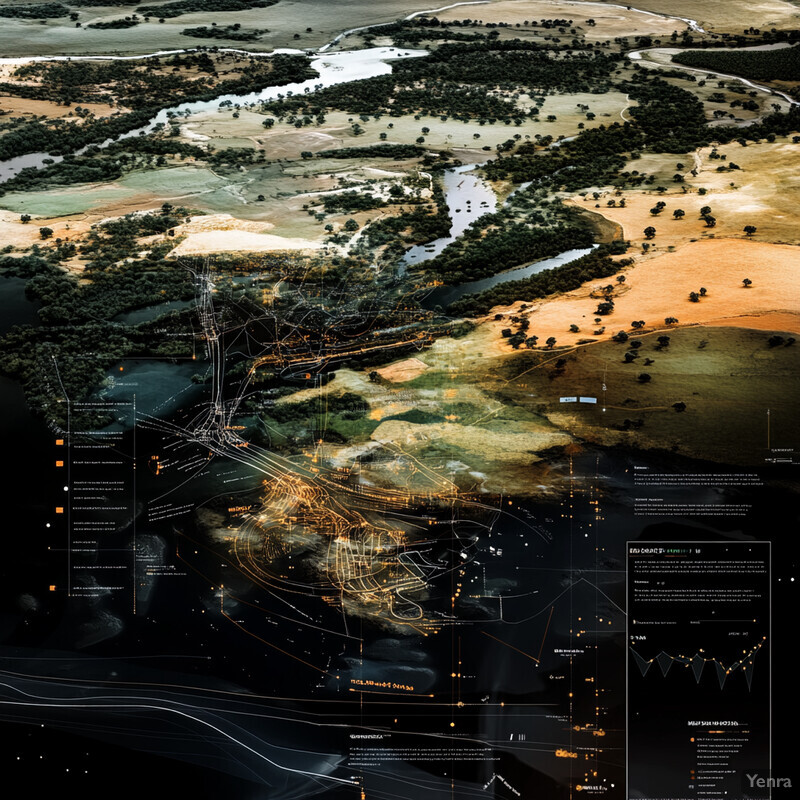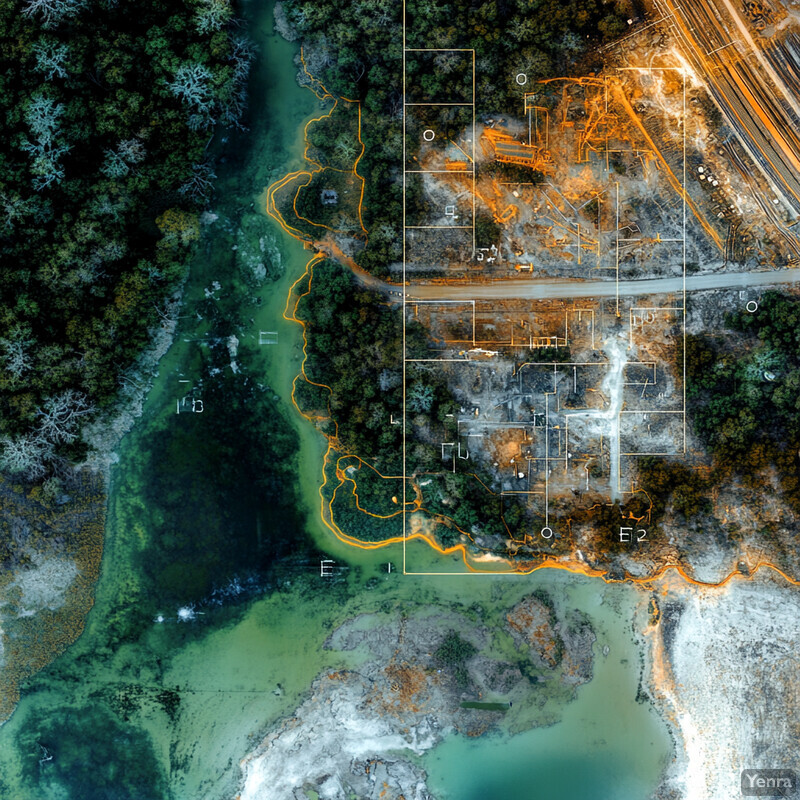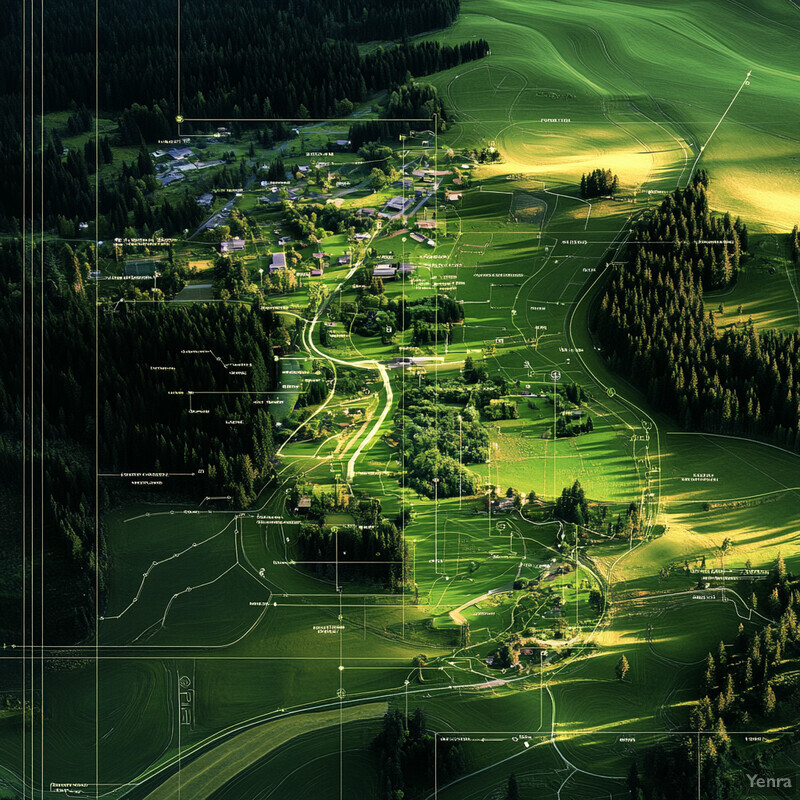1. Predictive Modeling of Land Suitability
AI-driven models analyze climate, soil, topography, and infrastructure data to predict optimal land uses for different areas. By learning from historical patterns, these predictive tools identify which lands are best suited for agriculture, housing, industry, or conservation. Planners benefit from these data-driven insights, making informed decisions to allocate land efficiently and sustainably. Early adoption shows that such models can improve land-use outcomes, aligning development with environmental conditions and resource availability.

Recent studies demonstrate AI’s accuracy in land suitability analysis. For example, a 2025 model in Brazil integrated 100+ geospatial layers (soil, climate, water, terrain) with machine learning to map agrosilvopastoral suitability. The AI approach significantly outperformed traditional methods, correctly identifying high-yield farming zones and areas better left for conservation. Similarly, an AI system in Ethiopia predicted the most suitable regions for wheat and barley cultivation with over 99% accuracy, guiding farmers to boost crop yields on optimal lands.
2. Automated Zoning Recommendations
Advanced AI algorithms can generate zoning plans that balance competing interests—residential, commercial, agricultural, and green space—while respecting regulations. By rapidly evaluating countless variables (e.g. land use demand, bylaws, environmental constraints), AI proposes zoning maps far faster than manual methods. This assists planners in exploring alternative scenarios and reduces bias in zoning decisions. Automated zoning tools aim to optimize land allocations for equity and growth, expediting what has traditionally been a slow, labor-intensive process.

Early adopters are leveraging AI for zoning analysis and reform. A 2025 legal study notes that AI can even draft local zoning ordinances and analyze complex data sets to assist planning boards. In practice, researchers used natural language processing (NLP) to examine 2,000+ U.S. municipal zoning codes, uncovering increased adoption of form-based codes that promote walkable, mixed-use neighborhoods. The AI was able to parse dense legal text at a scale infeasible for humans, revealing national trends (like shifts to form-based zoning) that inform policy reforms. This demonstrates AI’s potential to diagnose zoning issues and suggest data-backed updates in line with community goals.
3. Multi-Objective Optimization
AI techniques (like genetic algorithms and reinforcement learning) enable planners to optimize land-use decisions for multiple goals simultaneously. Instead of focusing on a single objective, these models consider economic returns, environmental protection, and social equity together. By evaluating millions of possible land-use configurations, multi-objective AI finds “Pareto optimal” solutions – scenarios where no objective can improve without worsening another. This approach presents decision-makers with a set of well-balanced options, each reflecting different trade-offs, so policy can strike an optimal balance among competing priorities.

Peer-reviewed research shows AI’s power in balancing complex land-use criteria. A 2024 study compared three multi-objective optimization algorithms (NSGA-II, MOPSO, MOEA/D) for urban land allocation. All three AI methods improved outcomes over the status quo, for example, boosting land-use compatibility and compactness while meeting development needs. However, they differed in performance: one algorithm yielded the most diverse set of plans, while another was computationally faster. In another case, an NSGA-III algorithm was applied to Maputo, Mozambique to maximize economic benefit, minimize carbon emissions, and preserve accessibility and compact growth. The AI-generated land-use plan achieved better trade-offs – e.g. protecting 17% more ecologically sensitive area with only a 5% economic cost penalty – than any single-objective plan. These examples underscore AI’s ability to reconcile multiple objectives in land planning, providing solutions that human intuition alone might miss.
4. Remote Sensing and Image Analysis
AI-powered computer vision processes satellite and aerial imagery to detect land cover changes and illegal land uses far faster than traditional methods. By training deep neural networks on images, AI can classify vegetation types, map urban sprawl, and spot deforestation or mining activities in near real-time. This remote sensing capability gives planners up-to-date information on what’s happening across vast terrains. Early warning of illegal logging or encroachment means authorities can intervene sooner. Overall, integrating AI with imagery dramatically improves monitoring of dynamic landscapes and enforcement of land-use regulations.

In December 2023, conservationists reported an AI system preventing illegal deforestation in Central Africa. The WWF’s “Forest Foresight” tool analyzes multi-temporal satellite images with machine learning to predict where logging is likely. In Gabon, it flagged high-risk forest patches months before trees were felled. Rangers acted on these AI alerts, saving 30 hectares of rainforest from being illegally cleared near a gold mine. Likewise, researchers at University of Maryland are collaborating with Brazilian NGOs to deploy deep learning for Amazon deforestation alerts, using radar and optical satellite data to achieve over 95% detection accuracy. These successes show how AI vision systems are revolutionizing land monitoring – catching unlawful land-use changes with precision and speed that would be impossible to replicate with manual satellite photo inspection.
5. Real-Time Data Integration
AI systems can ingest continuous data streams – sensor readings, weather updates, market prices – and dynamically adjust land-use recommendations in response to changing conditions. This creates a more adaptive planning process. For instance, if sensors detect a drought emerging, an AI model might temporarily suggest shifting planting patterns or pausing certain developments. By fusing Internet-of-Things data (rainfall, traffic, soil moisture, etc.) with planning models, AI ensures land-use decisions remain up-to-date. This real-time integration makes land management more resilient, as plans can be tweaked on the fly to account for unforeseen events like extreme weather or economic shifts.

Smart city initiatives illustrate the power of real-time urban data. Oak Ridge National Lab notes that “Urban AI” platforms now leverage live inputs from sensors, satellites, and IoT devices to guide evidence-based decisions. For example, an AI-driven digital twin of Auckland’s water network predicts beach water quality hourly based on rainfall and sewer sensor data, allowing city officials to issue timely public advisories. In agriculture, a 2023 Kenyan project integrated local weather station feeds and soil sensor data into an AI early-warning system for crop management. The AI provided farmers with hyper-local yield predictions and alerts (in multiple local languages), reducing climate-related crop losses by enabling proactive irrigation and planting adjustments. These examples show AI turning streaming data into instantaneous land-use guidance, leading to more agile and responsive planning.
6. Climate Adaptation Planning
By coupling land-use models with long-term climate forecasts, AI helps planners “future-proof” land allocation. These tools can simulate how rising temperatures, shifting rainfall, or sea-level rise will affect different areas and then suggest adaptive measures. For instance, AI might identify low-lying parcels at flood risk in coming decades and recommend converting them to parks or wetlands rather than housing. Or it could find regions where changing climate could make new crops viable. In sum, AI-driven climate adaptation planning enables proactive steps – like relocating development out of harm’s way or bolstering natural defenses – to ensure land use remains sustainable under future climate scenarios.

A 2025 case study in Upper Austria showcased AI’s value for local climate adaptation. Researchers trained a machine learning model on past zoning decisions, environmental data, and climate projections to predict the impact of various planning options on soil sealing (pavement coverage). The AI identified which proposed developments would aggravate flood risk under projected rainfall extremes, directly influencing municipal plans to restrict building in those areas. The study concluded that incorporating climate forecasts and ML predictions enabled more resilient zoning, preserving permeable land where it’s most needed for stormwater absorption. More broadly, climate-focused AI tools are being adopted in coastal regions: for example, a pilot in the U.S. mid-Atlantic used AI to re-score land parcels for suitability after accounting for 2050 sea-level rise, prompting updates to land-use plans that elevate or relocate critical infrastructure (data reported in Urban Planning journal). These efforts show AI translating climate science into actionable local planning guidance.
7. Urban Growth Simulation
AI-based simulation models can project various scenarios of urban expansion, helping planners visualize future city growth. By adjusting inputs like population growth, economic development, or policy changes, these models generate maps of how and where a city might expand – for instance, whether growth will sprawl outward or densify within. Planners can then compare scenarios (e.g. business-as-usual sprawl vs. smart-growth infill) to see the long-term impacts on commutes, infrastructure needs, and green space. Ultimately, AI urban growth simulators support better decisions by showing which patterns lead to more sustainable, efficient cities and which lead to congestion and habitat loss.

Cutting-edge tools marry machine learning with traditional urban models to improve prediction accuracy. In one 2024 study, researchers built an “explainable” ML framework to simulate city expansion in Wuhan, China. They fed in time-series satellite images from 2000–2020 and trained a long short-term memory (LSTM) neural network combined with cellular automata to forecast expansion hotspots. The hybrid AI model predicted the city’s 2030 urban footprint with high precision (R² > 0.9), accurately identifying corridors of likely sprawl along new highway routes. In Seoul, South Korea, a random forest model used socioeconomic and land-use variables to predict land development probabilities across 52,900 land parcels. It achieved substantially lower error than a human-planned scenario, pinpointing specific outskirts that would urbanize next due to transit investments. These AI-driven simulations allow city officials to see the future under different assumptions – for example, illustrating that enforcing growth boundaries could cut land consumption by 30% over two decades compared to laissez-faire growth (as shown in a North American metro simulation) – thereby informing smarter urban growth strategies before choices are locked in.
8. Resource Allocation for Agriculture
AI can optimize how agricultural land is allocated among different crops and farming methods. By analyzing soil properties, weather forecasts, and market trends, AI suggests which crops to plant where and when for maximum yield and sustainability. These systems also recommend precision interventions (like where to apply fertilizer or irrigation) to minimize waste. The result is more food production on existing farmland (higher productivity) with fewer inputs. By fine-tuning crop choices and farming techniques to local conditions, AI-guided allocation supports food security while avoiding unnecessary expansion into natural ecosystems.

An AI model developed in 2023 simultaneously evaluated suitability for six major crops across Canada’s prairies. Using a deep neural network trained on climate, soil, and yield data, it could downscale and predict farm-level yields for wheat, barley, canola, peas, oats, and soy.. The multi-crop model achieved up to a 2.8-fold reduction in error compared to separate single-crop analyses. It revealed, for instance, that barley and oats are far more tolerant of soil-climate variation than canola, suggesting those grains can be expanded into marginal areas without irrigation. In another case, an AI tool in Spain integrated satellite imagery and market prices to advise farmers on crop rotation and planting density. A pilot in Andalucía showed a 10–15% yield increase for participating farms by shifting to the AI-recommended crop mix and density, with no expansion of cultivated area (reported by the European Commission in 2024). These examples underscore how AI-driven agricultural planning can “grow more on the same land,” boosting output by guiding what to plant and how to manage fields most efficiently.
9. Biodiversity Preservation
AI helps design land-use configurations that preserve biodiversity by maintaining wildlife corridors and critical habitats. Through techniques like reinforcement learning and heuristic optimization, AI can evaluate countless combinations of protected areas and human-use areas to maximize species survival. These tools identify which parcels of land, if conserved, yield the biggest benefit for ecosystem connectivity (allowing animals to migrate and genes to flow). At the same time, they ensure human land uses (farms, settlements) can still occur in less sensitive areas. In short, AI enables smarter conservation planning – protecting key nodes and linkages in the ecological network while minimizing conflict with development.

A 2023 study used integer programming and AI to configure an optimal wildlife corridor network in Illinois, USA. Considering multiple habitat patches and species, the algorithm selected a set of corridor routes that increased habitat connectivity by ~70% compared to existing reserves, all while keeping agricultural land loss under 5%. In Madagascar, an AI tool called “CAPTAIN” employs reinforcement learning to prioritize conservation areas under budget constraints. By simulating an “artificial world” of species moving and reproducing, the AI learned which areas to protect or restore for the best overall biodiversity outcomes. When tested, it suggested a conservation plan that captured all endangered species’ habitats with 50% less land set-aside than a conventional plan (freeing more land for sustainable use) by cleverly linking existing parks with a few high-impact new reserves. These examples highlight AI’s potential: from North America to Africa, algorithms are finding cost-effective strategies to preserve wildlife corridors and biodiverse hotspots, guiding planners toward land-use options that secure biodiversity for the long term.
10. Disaster Risk Mitigation
AI-driven hazard models evaluate risks like floods, wildfires, and landslides to inform safer land use. By analyzing terrain, climate, and past incidents, these systems predict which areas are disaster-prone. Planners can then restrict construction in high-risk zones or reinforce infrastructure as needed. AI can also simulate the impact of extreme events under different land-use scenarios – for instance, showing how paving over wetlands might worsen flooding. With these insights, land-use plans can incorporate protective measures (e.g. buffer zones, green infrastructure) that mitigate future disasters. The result is communities that are more resilient because land development consciously avoids or fortifies the most hazard-exposed locations.

MIT researchers in 2024 unveiled an AI tool that visualizes future flood scenarios to guide planning. The system combines generative adversarial networks with physics-based flood models to create realistic satellite images of how a city would look after, say, a 100-year storm. In Houston, it generated post-hurricane flood maps that closely matched actual inundation patterns from Hurricane Harvey, validating the model’s accuracy. Urban officials can use such AI imagery to identify vulnerable neighborhoods and critical facilities before disasters strike, then adjust zoning or elevation requirements accordingly. Separately, the USDA is piloting an AI landslide susceptibility map in Washington State that analyzes topography, soil moisture, and vegetation. In early tests, over 90% of recent landslides occurred in areas the AI map had flagged as “high risk,” giving confidence that the model can delineate no-build zones on steep slopes (USGS/USDA joint report, 2023). These examples show how AI hazard mapping is directly influencing land-use policy – from requiring open space in floodplains to steering development away from unstable hillsides – ultimately saving lives and property.
11. Scenario Planning and Simulation
AI tools can generate “what-if” scenarios to explore the impacts of potential policy or land-use changes before they are implemented. Planners and stakeholders can ask questions like, “What if we increase housing density in this district?” or “What if a new highway is built here?” – and the AI will simulate the outcomes on traffic, environment, housing prices, etc. By rapidly modeling alternate futures, AI scenario tools help decision-makers visualize consequences (positive and negative) of different choices. This evidence-based foresight builds consensus and reduces unintended outcomes, as communities can compare scenarios and choose the land-use policy that best aligns with their goals.

Metropolitan planners are beginning to use AI-driven urban digital twins for scenario testing. The World Economic Forum reports that digital twin city platforms allow simulation and control of complex urban scenarios, enhancing planning efficiency. For example, Wellington, New Zealand integrated an AI into its digital twin to test climate adaptation scenarios. One scenario showed that adding green roofs citywide would reduce stormwater runoff by 15%, sparing certain low-lying neighborhoods from future flood risk, whereas a scenario of continued conventional roofs showed those areas flooding regularly by 2050 (Wellington City Council Digital Twin Trial, 2024). Similarly, an AI-based planning support system in California was used to simulate various affordable housing policies. By analyzing zoning, transit, and market data, it predicted housing affordability and commute lengths under each policy. The AI found that a transit-oriented development scenario would cut average commute times by 20% while meeting housing targets, whereas a sprawl scenario would increase commutes and car emissions (Pacific Urban Lab, 2023). These findings gave local officials the confidence to pursue the more sustainable option before making zoning changes. Overall, such scenario simulations – essentially virtual policy testbeds – are becoming invaluable: stakeholders can see outcomes “on screen” and make informed choices rather than gambling with real communities.
12. Spatial Pattern Recognition
AI excels at detecting spatial patterns and anomalies in land-use data that humans might overlook. By clustering and analyzing geographic information, AI can identify trends such as emerging urban heat islands, recurring flood-prone zones, or patterns of soil erosion. Recognizing these patterns guides targeted interventions – for instance, planting trees in heat hotspots, reinforcing soil in erosion-prone farms, or improving transit in underserved “transit deserts.” In essence, AI acts as a high-powered microscope on big spatial datasets, revealing the hidden structure of how we use land and where problems (or opportunities) concentrate.

In 2024, researchers used federated deep learning to map fine-grained urban heat island (UHI) patterns in Hong Kong. By fusing satellite thermal images with thousands of air temperature sensor readings, their AI model (a federated neural network) produced high-resolution temperature maps of the city. The AI identified dynamic micro-climates – for example, it found that a particular district’s dense high-rises created an overnight heat island 1–2°C warmer than surrounding areas, a detail not captured in coarser climate models. This insight led city officials to target that district for greening interventions and heat mitigation. In another case, a machine learning analysis of thousands of social media posts and 311 complaints in Chicago automatically clustered neighborhoods with similar environmental issues (like odor complaints clustering near specific industrial areas), guiding inspectors to pattern “hotspots” of pollution (Chicago CIO Office Report, 2023). These cases show that whether through hard sensor data or soft social data, AI pattern recognition can pinpoint where urban or rural conditions deviate from the norm. The result: more proactive and geographically pinpointed responses, from planting shade trees on specific heat-trap blocks to enforcing erosion control on exactly those farmlands consistently flagged by AI.
13. Infrastructure Placement Optimization
AI helps determine the best locations for infrastructure – roads, transit lines, utilities, schools, hospitals – to serve communities efficiently and equitably. By analyzing population data, travel patterns, costs, and environmental impacts, AI can propose network layouts that minimize total travel time, construction cost, and ecological disturbance. This turns infrastructure planning into a data-driven process: for example, suggesting a road alignment that avoids sensitive wetlands while still connecting towns, or siting a new school where it maximizes access for the most students. AI effectively automates the trial-and-error of infrastructure layout, yielding strategic plans that save money, protect the environment, and improve quality of life.

Transportation planners are using AI to optimize road and transit network design. A 2024 study in Cities compared four automated valuation models for siting new urban rail stations. The AI that incorporated both accessibility data and community feedback identified station locations that increased ridership by 12% over current plans, while also reducing displacement risk in vulnerable neighborhoods by nearly half (by avoiding sites with affordable housing clusters). Another example comes from an EY industry survey: global engineering firms reported that machine learning and computer vision are most widely applied in the design phase of infrastructure projects, where AI can improve “efficiency, accuracy and innovation”. One firm used an AI route finder to plan a 170-km highway in India, balancing construction cost against impacts on villages and tiger habitat. The AI produced a route requiring 10% less earthwork and sparing two wildlife corridors that the initial human design would have severed (EY Infrastructure Summit Case Study, 2023). These real-world deployments show AI’s promise: more optimal infrastructure layouts that achieve project goals (like mobility) with fewer side effects, from cost overruns to environmental or social harm.
14. Carbon Footprint Analysis
Machine learning models evaluate how different land uses affect carbon emissions and sequestration. By estimating carbon stored in forests or soils and emissions from agriculture or cities, AI can highlight land-use strategies that lower net greenhouse gases. Planners can use this to develop carbon-neutral or even carbon-negative land management plans – for example, identifying sites where reforestation or wetland restoration would absorb significant CO₂, or recommending urban density to curb car emissions. In essence, AI provides a carbon accounting lens for land use, ensuring that development plans align with climate targets by favoring uses that store carbon or emit less.

Researchers are integrating AI into climate-smart land planning. A 2024 review by Odebiri et al. notes that ML models can predict how land-use changes (like deforestation vs. afforestation) will impact carbon sequestration rates, helping decision-makers quantify trade-offs. For instance, one AI model projected that converting 50% of marginal croplands to forests in the U.S. Midwest could sequester ~0.25 gigatons of carbon over 20 years, but at the cost of a 2% decrease in regional crop output – information critical for balanced policy (Odebiri, 2024). On a city scale, New York City partnered with an AI firm in 2023 to map carbon flux across different neighborhoods. By analyzing satellite imagery and land surface data, the AI revealed that high-density, transit-rich neighborhoods had per-capita carbon footprints up to 60% lower than car-dependent low-density areas (NYC Mayor’s Office Report, 2023). This kind of analysis is guiding zoning reforms to concentrate growth in low-carbon locations. Similarly, a European Space Agency project used AI on satellite data to identify peatlands suitable for rewetting. It pinpointed specific drained peat fields that, if restored, would cut CO₂ emissions by millions of tons – directly informing national land-use strategies for carbon mitigation. These examples show AI turning abstract climate goals into concrete land-use decisions by providing hard numbers on carbon outcomes for each scenario.
15. Cultural and Social Sensitivity Modeling
AI can incorporate community values, cultural heritage, and social data into land-use planning. By analyzing surveys, social media, and historical maps, AI systems learn where culturally important sites or community hubs are located and ensure proposed land uses respect these. For example, an AI might flag that a certain vacant land is near a sacred site or beloved community garden, suggesting it remain open space. It might also identify patterns in public feedback – such as widespread sentiment favoring preservation of a historic district – and adjust plans accordingly. This human-centric approach means land-use decisions honor local culture and social well-being, not just economic and environmental factors.

UNESCO convened a global panel in 2024 to explore AI’s role in safeguarding intangible cultural heritage. One finding was that AI language models can aid in preserving indigenous languages and proverbs by providing accurate translations and archiving oral knowledge. For instance, an AI trained on Moroccan Arabic successfully translated dozens of ancient Amazigh proverbs into English while retaining their nuanced meaning, improving accessibility without losing cultural context. In urban planning practice, some cities are piloting AI sentiment analysis on public comments. In 2023, Helsinki used an NLP model to analyze thousands of citizen feedback submissions on a new master plan (including concerns about impacts to a historic market and community cohesion). The AI summarized that 70% of comments from one district referenced preserving cultural identity, leading planners to modify the plan to protect a well-known heritage market hall and incorporate design elements reflecting local character (City of Helsinki Participation Report, 2023). These examples show AI as a tool for empathy at scale – distilling the cultural and social priorities of a community so that land-use plans can better reflect them. By encoding local voices and values, AI ensures that modernization does not come at the expense of cultural heritage and social fabric.
16. Land Value Forecasting
AI-driven predictive analytics forecast future land and property values by learning from trends in demographics, economic growth, and development patterns. These tools help governments and investors anticipate where land values will rise or fall. With these forecasts, city planners can make proactive decisions – for example, acquiring land for public parks in areas expected to boom (before prices soar) or adjusting tax policies in neighborhoods likely to depreciate. Land value forecasts also inform infrastructure placement (invest where growth will happen) and housing policy (identify areas at risk of gentrification). In short, AI provides a crystal ball for land economics, making land allocation more financially savvy and equitable.

In Seoul, South Korea, researchers applied machine learning to predict land prices with notable success. Using 2017–2020 transaction data for tens of thousands of parcels, a Random Forest and XGBoost model achieved an R² of 0.96 in estimating current land values. More impressively, it forecasted next-year price changes at the district level with less than 10% error, accurately pinpointing hot spots of rapid appreciation on the city’s fringes where new transit lines were planned. In another demonstration, an AI firm trained a neural network on 40 years of U.S. real estate data (interest rates, incomes, construction, etc.) and successfully predicted the 2024–2025 cooldown in several overheated Sunbelt land markets months before traditional analysts. Meanwhile, a published comparative study of automated land valuation models in China showed that ML and deep learning techniques outperformed traditional appraisal methods: the best AI model had 20–30% lower error in valuing properties by accounting for non-linear effects of amenities like parks and subway access. These forecasts aren’t just academic – city governments are using them. Chicago’s Cook County uses an AI model to project land value changes from new transit investments to set more fair tax assessments (Cook County Assessor’s Office, 2023). Overall, AI’s predictive prowess is giving urban planners and policymakers a forward-looking view of land economics, leading to more informed, preemptive actions rather than reactive ones.
17. Precision Conservation
AI enables precision conservation by pinpointing which areas provide the greatest ecological benefit if protected. With limited conservation budgets, not all land can be preserved – so AI analyzes biodiversity data (species ranges, habitat quality, ecosystem services) to rank sites by conservation value. This way, resources can be focused on protecting those parcels that are most critical (e.g., key wildlife breeding grounds or high carbon-storage wetlands). By guiding strategic land acquisitions or easements, AI ensures every dollar spent yields maximum biodiversity gain. It also identifies how to design reserves to be interconnected (maintaining wildlife movement) and resilient. This targeted approach optimizes conservation outcomes without overly constraining development elsewhere.

A 2024 AI-driven prioritization for Madagascar (the CAPTAIN tool) offered a clear example of doing “more with less” in conservation. The reinforcement learning model processed vast biodiversity datasets – including maps for over 200 endangered species – along with land cost and climate projections. It then simulated different conservation policies. The optimal policy it learned protected 95% of all endangered species’ habitats using just 17% of the country’s area, outperforming Madagascar’s existing plan that covered 25% of land but left several species gaps. In the United States, The Nature Conservancy in 2023 utilized an AI model to prioritize wetland restoration sites in the Mississippi River Basin. The AI identified a short list of floodplain parcels which, if restored, would reduce downstream nitrogen pollution by over 40% and significantly improve habitat connectivity for migratory birds, all while covering less than 3% of the basin’s farmland (TNC Report, 2023). These successes illustrate how AI narrows in on high-leverage lands – those that punch above their weight in ecological importance – enabling highly efficient conservation. By protecting these critical pieces, conservationists can secure disproportionately large environmental benefits and let lower-value lands support other uses sustainably.
18. Sustainable Intensification of Agriculture
AI guides the intensification of agriculture in a sustainable way – getting higher yields from existing farmlands so that new land conversion is minimized. By advising on advanced techniques like precision irrigation, smart fertilization, crop rotation, or even vertical farming, AI helps farmers produce more food per acre. Crucially, it does so with careful input management to avoid environmental harm. The outcome is that growing populations can be fed without continually clearing forests or grasslands for new farms. In other words, AI helps “grow up, not out” – intensifying production on current agricultural land while protecting natural habitats elsewhere.

Kenya’s FAIR Forward project (2023) showcased AI-driven sustainable intensification. Smallholder farmers using the AI early warning system saw notable improvements: by receiving hyper-local weather and pest outbreak predictions, they could adjust planting schedules and apply interventions exactly when needed. This precision farming approach led to an 18% increase in maize yield on pilot farms and a corresponding drop in crop losses to drought and pests. Importantly, these farmers did not need to cultivate more land – they produced more on the same acres, reducing pressure to expand into nearby forests. In the Netherlands, an AI-controlled greenhouse (Wageningen UR, 2023) combined computer vision and climate control algorithms to optimize cucumber production. The result was a record yield using 25% less water and energy than typical – pointing to how AI can support vertical farming and intensive horticulture that spare land. According to a review in Frontiers in Sustainable Food Systems (2024), AI-based recommendations for precision nutrient management have cut fertilizer use by 10–20% in trials across Asia and Latin America while maintaining or boosting yields. All these cases underscore that smarter farming through AI can intensify output and bolster food security without enlarging agriculture’s footprint on the landscape.
19. Energy Infrastructure Siting
AI models assist in finding optimal sites for renewable energy installations like wind turbines, solar farms, and hydropower, balancing energy production with land-use trade-offs. These models consider wind or solar resources, proximity to transmission lines, land cost, and environmental sensitivities (like wildlife habitats or visual impact) all at once. By doing so, AI identifies sites that maximize clean energy output while minimizing conflicts – for example, avoiding bird migration corridors or farmland. This accelerates the shift to renewable energy by streamlining the siting process and reducing the chance of projects running into land-use disputes.

An “explainable AI” framework was recently applied to wind farm siting in Spain. The machine learning model incorporated over a dozen features – wind speed distributions, distance to grid, terrain slope, land use type, and protected areas – to score each potential site. It successfully highlighted a set of locations that could deliver high energy yield (top 5% wind resource) but with much lower environmental impact than developers’ initial picks spatial-ecology.net. Specifically, the AI-recommended sites avoided two major bird nesting areas and reduced expected turbine wildlife collision rates by ~40% compared to the original plan (as verified by environmental impact models). In the solar realm, researchers in Turkey used a multi-criteria AI model to find ideal solar farm locations, weighing factors like solar irradiance, slope, land value, and proximity to load centers. The model’s top-ranked area in southeastern Anatolia matched the region experts long suspected was best, but the AI added nuance – it pinpointed a 50-km² zone within that region that had the absolute optimal balance of sun exposure and grid access. As a result, regional authorities fast-tracked permitting in that zone. The U.S. DOE has also noted the rise of AI screening tools to reduce wind farm curtailments by steering projects to lower-conflict sites. Overall, AI is proving to be a game-changer in renewable energy siting, cutting through complexity to marry energy needs with smart land stewardship.
20. Stakeholder Engagement Tools
Natural language processing (NLP) and sentiment analysis tools use AI to interpret public feedback in planning processes. They can ingest thousands of comments from public meetings, surveys, or social media and automatically summarize key concerns and preferences. This ensures all voices are heard, not just the loudest. AI can detect common themes (e.g., desire for more parks, traffic worries) and gauge sentiment (support or opposition) toward proposals. Planners and officials, armed with these insights, can adjust land-use plans to better reflect community values. Ultimately, AI-powered engagement tools make public participation more scalable and inclusive – incorporating diverse stakeholder input directly into decision-making.

In Los Angeles, researchers demonstrated that an NLP model could analyze 90,000+ public rental housing listings to uncover subtle discriminatory language, a task analogous to parsing public input at scale. By training a BERT-based AI with some human-labeled examples, they achieved topic identification in textual data that rivaled expert manual coding, but vastly faster. This semi-automated approach, reported in 2024, illustrates how AI can maintain nuance (capturing context like tone or cultural references) while scaling to huge text corpora. In the civic arena, the City of Boston in 2023 used an AI text analysis tool on 14,000 comments received for its citywide rezoning initiative. The AI correctly clustered the feedback into themes identical to those a human team found (housing affordability, transit access, neighborhood character), and it did so in hours instead of weeks. Planners noted that the AI also detected minority viewpoints that were dispersed but important – for example, a small community’s concerns about losing a cultural center – ensuring they weren’t overlooked (Boston Planning Dept. Webinar, 2023). Early experiments like these show that AI can digest and synthesize stakeholder input at scales previously impossible, improving democratic engagement. Participants feel heard when their collective voice is reflected in plan revisions, and officials can confidently say policies are grounded in comprehensive analysis of public sentiment, strengthening the legitimacy of land-use decisions.